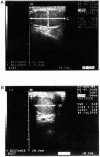The reliability of ultrasonographic measurements for testicular volume assessment: comparison of three common formulas with true testicular volume
- PMID: 19151736
- PMCID: PMC3735018
- DOI: 10.1038/aja.2008.48
The reliability of ultrasonographic measurements for testicular volume assessment: comparison of three common formulas with true testicular volume
Abstract
The aim of this study was to determine the correlation of ultrasonographic estimates of testicular volume with true testicular volume and to compare the accuracy and precision of the three most commonly utilized formulas. A total of 15 patients underwent high-resolution ultrasonography (US) analysis for testicular volume before orchiectomy. Testicular volume was calculated using three common formulas: (1) length (L) x width (W) x height (H) x 0.52; (2) the empirical formula of Lambert: L x W x H x 0.71; and (3) L x W2 x 0.52. The actual volume of each removed testis was estimated directly by a water displacement method. Thus, four volume measurements were obtained for each of the 30 testes. The obtained data were analyzed by paired t-test and linear regression analysis. All three US formula measurements significantly underestimated the true testicular volume. The largest mean biases were observed with US formula 1, which underestimated the true volume by 3.3 mL (31%). US formula 2 had a smaller mean difference from the true volume, with an underestimation of only 0.6 mL (6%). Regression analysis showed that formulas 1 and 2 had better R2 values than formula 3. However, all three US formulas displayed a strong linear relationship with the true volume (R2= 0.872-0.977; P < 0.001). Among the commonly used US formulas, the empirical formula of Lambert (L x W x H x 0.71) provided better accuracy than the other two formulas evaluated, and better precision than formula 3. Therefore, the formula of Lambert is the optimal choice in clinical practice.
Figures


Similar articles
-
Testicular volume measurement: comparison of ultrasonography, orchidometry, and water displacement.Urology. 2007 Jan;69(1):152-7. doi: 10.1016/j.urology.2006.09.012. Urology. 2007. PMID: 17270639
-
Testicular volume: comparison of orchidometer and US measurements in dogs.Radiology. 2002 Jan;222(1):114-9. doi: 10.1148/radiol.2221001385. Radiology. 2002. PMID: 11756714
-
Measurement of testicular volume in smaller testes: how accurate is the conventional orchidometer?J Androl. 2009 Nov-Dec;30(6):685-9. doi: 10.2164/jandrol.108.006460. Epub 2009 Jul 3. J Androl. 2009. PMID: 19578133
-
The role of ultrasound in assessment of male fertility.Eur J Obstet Gynecol Reprod Biol. 2009 May;144 Suppl 1:S192-8. doi: 10.1016/j.ejogrb.2009.02.034. Epub 2009 Mar 20. Eur J Obstet Gynecol Reprod Biol. 2009. PMID: 19303691 Review.
-
Simplified Sample Size Formulas for Detecting a Medically Important Effect.Indian J Community Med. 2024 May-Jun;49(3):464-471. doi: 10.4103/ijcm.ijcm_787_23. Epub 2024 May 24. Indian J Community Med. 2024. PMID: 38933799 Free PMC article. Review.
Cited by
-
The Impact of Maternal Hypothyroidism during Pregnancy on Minipuberty in Boys.J Clin Med. 2023 Dec 13;12(24):7649. doi: 10.3390/jcm12247649. J Clin Med. 2023. PMID: 38137718 Free PMC article.
-
The Impact of Maternal Gestational Diabetes Mellitus on Minipuberty in Boys.Nutrients. 2024 Nov 29;16(23):4145. doi: 10.3390/nu16234145. Nutrients. 2024. PMID: 39683537 Free PMC article.
-
Intra- and Interobserver Variability in Ultrasound Measurement of Testicular Volumes in Pubertal Boys.Children (Basel). 2024 Jun 17;11(6):741. doi: 10.3390/children11060741. Children (Basel). 2024. PMID: 38929320 Free PMC article.
-
Does Size Matter? Testicular Volume and Its Predictive Ability of Sperm Production in Rams.Animals (Basel). 2023 Oct 13;13(20):3204. doi: 10.3390/ani13203204. Animals (Basel). 2023. PMID: 37893928 Free PMC article.
-
The dilemma of adolescent varicocele.Pediatr Surg Int. 2015 Jul;31(7):617-25. doi: 10.1007/s00383-015-3698-8. Epub 2015 Apr 19. Pediatr Surg Int. 2015. PMID: 25895069 Review.
References
-
- Takihara H, Cosentino MJ, Sakatoku J, Cockett AT. Significance of testicular size measurement in andrology: II. Correlation of testicular size with testicular function. J Urol. 1987;137:416–9. - PubMed
-
- Lenz S, Giwercman A, Elsborg A, Cohr KH, Jelnes JE, et al. Ultrasonic testicular texture and size in 444 men from the general population: correlation to semen quality. Eur Urol. 1993;24:231–8. - PubMed
-
- Arai T, Kitahara S, Horiuchi S, Sumi S, Yoshida K. Relationship of testicular volume to semen profiles and serum hormone concentrations in infertile Japanese males. Int J Fertil Women's Med. 1998;43:40–7. - PubMed
-
- Sakamoto H, Ogawa Y, Yoshida H. Relationship between testicular volume and testicular function: comparison of the Prader orchidometric and ultrasonographic measurements in patients with infertility. Asian J Androl. 2008;10:319–24. - PubMed
-
- Diamond DA, Paltiel HJ, DiCanzio J, Zurakowski D, Bauer SB. Comparative assessment of pediatric testicular volume: orchidometer versus ultrasound. J Urol. 2000;164:1111–4. - PubMed
Publication types
MeSH terms
LinkOut - more resources
Full Text Sources

